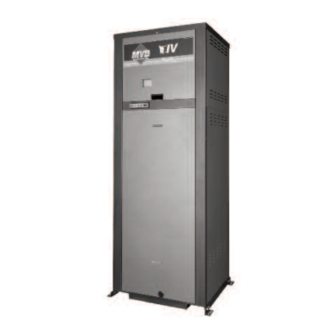
Table of Contents
Advertisement
INSTALLATION & OPERATING
Models 503A–2003A
Types H & WH
WARNING: Improper installation, adjustment, alteration, service or maintenance can
cause property damage, personal injury, exposure to hazardous materials* or loss of
life. Review the information in this manual carefully. *This unit contains materials that
have been identified as carcinogenic, or possibly carcinogenic, to humans.
FOR YOUR SAFETY: Do not store or use gasoline or other flammable vapors and
liquids or other combustible materials in the vicinity of this or any other appliance. To
do so may result in an explosion or fire.
WHAT TO DO IF YOU SMELL GAS:
• Do not try to light any appliance.
• Do not touch any electrical switch; do not use any phone in your building.
• Immediately call your gas supplier from a neighbor's phone. Follow the gas
supplier's instructions.
• If you cannot reach your gas supplier, call the fire department.
Installation and service must be performed by a qualified installer, service agency or
the gas supplier.
This manual should be maintained in legible condition and kept adjacent to the heater or in a safe place for future
reference.
CATALOG NO. 3400.531A
INSTRUCTIONS
Effective: 10-03-13
Replaces: 04-09-13
P/N 241511 Rev. 2
Advertisement
Table of Contents

Summarization of Contents
WARNINGS
Pay Attention to These Terms
Defines hazard alert terms like DANGER, WARNING, CAUTION, NOTE.
General Warnings
Lists critical safety warnings regarding gas leaks, overheating, water damage, electrical shock, and Proposition 65.
BEFORE INSTALLATION
Product Receipt
Instructions for checking the heater upon delivery for damage or missing items.
Model Identification
Guidance on locating and understanding the heater's model and serial number.
Ratings and Certifications
Lists standards and certifications the heater complies with, e.g., ANSI, CSA, ASME.
Component Locations
General Information
Provides basic data for different MVB models, including MBTUH input and vent sizes.
GENERAL SAFETY
Time/Temperature Relationships in Scalds
Details how water temperature relates to burn injury time, highlighting risks.
INSTALLATION
Installation Codes
Lists codes and standards that must be followed for installation.
Equipment Base
Mounting instructions for the heater on a suitable surface.
Clearances
Minimum clearances required for safety and servicing.
Combustion and Ventilation Air
Indoor Units
Requirements for supplying adequate combustion and ventilation air for indoor installations.
Outdoor Installations
Guidelines for installing heaters outdoors, including overhang and clearance requirements.
Conventional Combustion Air Supply
U.S. Installations
Details air supply requirements for US installations, focusing on openings for ventilation.
Water Piping
General
Locating the heater to prevent damage from leaks and requirements for water circulation.
Cold Water Operation
Discusses condensate evaporation system and potential issues with low inlet water temperatures.
Hydronic Heating
Pump Selection
Requirements for selecting the correct pump size based on system flow and temperature difference.
Piping
Air-Separation/Expansion Tank
Importance of using a properly sized expansion tank and air separator.
Gas Supply
Gas Supply Connection
Instructions for connecting the gas supply, including shut-off valves and testing.
Gas Supply Pressure
Requirements for gas supply pressure, regulators, and pressure testing.
Making the Electrical Connections
Check the Power Source
How to verify the incoming power supply voltage and polarity.
Venting
General
Emphasizes the critical role of proper flue venting for safe and efficient operation.
Appliance Categories
Classifies heaters into four categories based on vent pressure and condensate production.
Venting Configurations
Vertical Venting (Category IV)
Specific requirements for vertical venting systems, including condensate drains.
START-UP
Pre Start-up Procedures
Covers filling system, air purge, venting inspection, safety, checks, initial startup, and tools.
OPERATION
Lighting Instructions
Step-by-step guide for safely lighting the heater's burner.
To Turn Off Gas To Appliance
Procedures for safely shutting off gas to the appliance for service or emergencies.
TROUBLESHOOTING
MVB Error Codes and Faults
Explains error code display, heater errors, faults, and PIM™ LED codes.
MAINTENANCE
Suggested Minimum Maintenance Schedule
Outlines a schedule for regular service by qualified agencies and onsite staff.
Daily Checks
Daily checks include clearing the area and ensuring no obstructions to air flow.
Monthly Checks
Monthly checks cover piping leaks, burner flame, venting system, and air vents.
Yearly Checks
Annual service by a qualified agency, including vent inspection and cleaning.
Filter Maintenance
Filter Replacement
Step-by-step guide on how to remove and replace the air filter.
APPENDIX
Inside Air Contamination
Discusses how contaminated air affects condensate acidity and heater materials.
LIMITED PARTS WARRANTY
Warranty Scope and Exclusions
Covers warranty coverage, exclusions, and limitations of liability.
Making a Warranty Claim
Procedures for initiating a warranty claim, including contacting support.











Need help?
Do you have a question about the 1753A and is the answer not in the manual?
Questions and answers